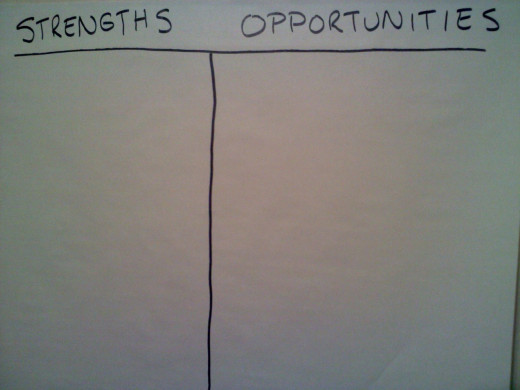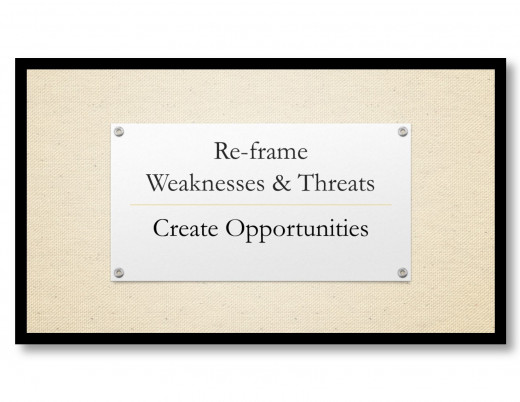Strategic Planning - Turn Challenges Into Opportunities
Direction & Focus

Facilitation Tip - Take a photo and then send it to yourself as a pdf
When facilitating a meeting where a lot of data is written on charts, take a photo of each of the the wall chart (I use my phone but a camera works too) and then send it to yourself and print it or save it to your computer.
One photo for each page of wall charts will give you the best clarity when accessing the photo.
Knowing that you can capture the written information by taking a photo rather than feeling compelled to write down copious notes allows participants to be more fully engaged in the session.
This is especially helpful when there are many drawings or flow charts drawn during the meeting.
Take a Photo

Get Rid of the W & T?
What do you think about categorizing weaknesses and threats as opportunities?
It is time to get rid of the WT in SWOT…SO what?
Strategic planning is critical to the success of any organization and although it does take time, the effort put into the process will pay dividends in the future.
A traditional tool used in strategic planning is called a SWOT. Participants are asked to list the Strengths, Weaknesses, Opportunities and Threats that face the organization during strategic planning.
Groups can get so focused on their weaknesses and threats that the process can get side-tracked. If your time is limited, try instead to identify all of the challenges and then categorize them into either a strength or an opportunity. From there the planning takes an asset-based approach and the process becomes streamlined (not shortened, but more efficient).
Making time to plan for a new year is important, and it is up to you as the leader of your organization to make strategic planning a priority. When you gather your team and begin with a Strength and Opportunity Analysis the process will begin in a positive frame and engage people immediately.
Get your strategic planning session on the calendar, it won't just magically happen. Reviewing and renewing the strengths and opportunities of your organization will keep you relevant and responsive. Take advantage of the new year and renew your team.
Begin With Strengths & Opportunities
Begin by asking each member of your team to write a list of qualities that your business or organization is known for, then on another piece of paper, to list qualities the the team member appreciates. Gather the ideas and review your STRENGTHS.
Conduct another exercise that asks your team to look into the future - what are you doing, providing or creating that is currently not in the portfolio. Gather these ideas and review your OPPORTUNITIES.
Engage in a facilitated discussion about strategies to leverage and capitalize on the identified strengths and to move the opportunities forward. While there are many exercises that can be conducted to drill down on the strengths and opportunities of your business, this si a quick and easy place to start the conversation.
As a strength-based, asset focused facilitator working with non-profits, community organizations and church groups I like to focus on the SO’s of the group. This article explains why dropping the WT from the standard SWOT could be useful for your organization when doing strategic planning.
Time to Re-frame the Conversation

Create A Call To Action
A SWOT analysis is a classic business strategic planning tool that stands for Strengths, Weaknesses, Opportunities” and Threats. During the SWOT analysis, the facilitator uses various exercises that bring up all of the organization’s, group’s, or department’s possibilities, current programming, market pressures, new products, environmental factors and future planning, etc., and then those items are categorized and charted on wall charts into the four areas: strengths, weaknesses, opportunities or threats. The SWOT is often a basis from which to launch and inform strategic planning.
Often, once a group has named something such as a weakness or threat it gains power. Then you put those weaknesses on the board creating opportunities to visualize the threats, giving those concepts even more power. This is not to say to ignore the challenges facing an organization, quite the contrary, threats to an organization must be acknowledged and strategized around; however, as an opportunity. The same is true for perceived weaknesses; they are opportunities.
Reframing threats or weakness into opportunities is a pro-active, empowering call to action. Here are some more in-depth strategies:
- List all of the opportunities on wall charts.
- Ask this question of all of the items:
- How will this opportunity be used make something happen? …create a system change that is critical? …evaluate a practice that may not be producing the results you expect?
- All of these opportunities can create change, forward progress and positive action.
To create a SO analysis chart:
- Draw a T on a wall chart to create two columns (see photo)
- Title the first column STRENGTHS.
- Title the second column OPPORTUNITIES.
- List all of the identified strengths and opportunities in the appropriate columns.
- Add more sheets of paper as the lists develop and evolve.
- You have created a SO chart from which to work.
When plotting the strengths with the opportunities, it becomes a much simpler task to match your strengths with the opportunities that are presented on the boards. Gaps in strengths will also become obvious and create new opportunities to gain skills, develop resources and increase capacity.
How will this opportunity be used to make something important happen?
Focus on Strengths and Opportunities

Rally Around Your Strengths
The next time you work through your strategic plan, consider categorizing the threats and weaknesses as opportunities around which to rally your strengths. You will spend much less time in the past or stuck in deficit thinking and move forward into creating a strength-based action plan.







